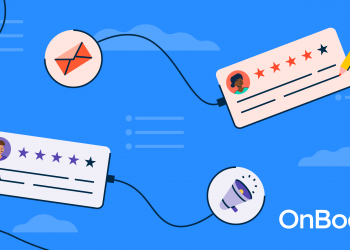Client Onboarding Checklist for Agencies – crowdspring Blog
Going through the entire sales cycle with a client can be draining.
From intricately preparing your pitch to negotiating the final contract, there’s a lot involved in closing the deal, which makes it understandable that you might want to sit back and relax as soon as you’ve got that last signature.
However, as one challenging stage ends, another begins. From here, it’s vital to make the right impression when kicking off your business relationship with the client, as it will set the tone for the rest of the project.
A client onboarding questionnaire is the best way to get the ball rolling. That way, you’ll be able to collect all the initial information you need to start working your marketing magic!
What is client onboarding?
Client onboarding is the process of onboarding and welcoming new clients to your agency.
Onboarding is crucial to any successful working relationship.
A smooth onboarding process provides a client with the much-needed reassurance that you’re invested in providing them with the best possible experience and maximizing results.
For you, onboarding is a simple way of clearly understanding your client’s main goals for the partnership and what they’re expecting of you.
Streamlining the onboarding process by sending a questionnaire is the most convenient way of doing things for both parties. The client can take their time and reflect before responding, and, in the end, you’ll be left with a much more precise and detailed result than you would have obtained over a quick phone call.
What questions should be included in an agency client onboarding questionnaire?
Generally, the questions you should be asking tend to be centered around the following:
- The company’s products/services
- The company’s values
- The company’s customer approach
- Why the company feels they need help from a marketing agency
- The company’s ideal customer profile
- The strengths and weaknesses of competitors
Considering the primary categories above, we’ve put together a list of 20 must-have questions to help you ace your next agency client onboarding questionnaire.
1. Who will be our first point of contact throughout this partnership?
Communication is undoubtedly the key when working with clients. With critical strategic decisions to be made, it’s vital to get in touch with the proper shareholder at the right time.
Want a $20 Amazon gift card?
Schedule a 15 minute call to learn how crowdspring can help you increase your agency’s profits.
We just emailed you the details.
2. Do you have a preferred secondary contact with whom we can also get in touch?
Collecting that second set of contact details opens up an even more comprehensive line of communication and ensures that clients aren’t left in the dark, even if the primary stakeholder isn’t available.
3. Do you have an existing company logo? If so, please upload it here.
A company logo is an essential marketing asset. If a client already has their final logo ready to go, it can save time and allow you to get started on the campaign’s creative elements faster.
4. Do you use particular fonts or colors throughout your company marketing materials? If so, please provide the details here.
Fonts and brand colors are also valuable marketing assets to get hold of early doors. They’re also crucial to maintaining consistent branding and a coherent company image.
5. What’s the main problem you’re looking to solve with your product/service?
It’s essential to get familiar with your client’s product development strategy. Getting to the bottom of the everyday issue your client’s product/service sets out to solve for their consumers will give you something to focus on when crafting the marketing strategy.
6. Please provide your company’s main value proposition.
Many companies struggle to answer this question. Why would a customer choose your product/service? Why do consumers buy from you?
7. What is the most prominent weakness in your business model?
This one might take a certain level of honesty from the client, but it’ll allow them to start feeling more comfortable opening up to you and exposing their weaknesses. After all, if you don’t know what they are, how can you go about fixing them?
8. Please list a few of your company’s core values.
It’s important to know what the client’s company stands for and what they believe in, as this will directly affect the way consumers and the overall community view them.
9. Is there a specific tone of voice you prefer using with your customers?
Funny. Casual. Formal. Matter-of-fact. These different tones of voice directly influence how a company reaches out to and engages with its audience via email, social media platforms, and, notably, within marketing materials.
10. Why do you feel customers might refrain from purchasing your product/service?
Time for some more home truths! The client’s answer to this question could be based on honest customer feedback or just a general inkling. Either way, it’s essential to figure out what might be preventing potential customers from pulling the trigger on that purchase.
11. Why do customers remain loyal to your company?
What secret ingredient keeps the client’s customers returning for more? It’s time to find out.
12. In a few sentences, please describe your ideal customer profile.
Having a detailed ideal customer profile in mind is one of the most valuable assets a company can have. A customer profile should include gender, age group, location, income, and hobbies, to paint a clear picture of who the product/service should target.
13. Which social media platforms does your ideal customer use daily?
This is the best way to determine which social media platforms would be ideal for paid media campaigns.
14. What other companies or influencers do they enjoy engaging with on social media?
Even if the client only provides a few ideas for this one, you may be able to use these to inspire the marketing approach you choose to take.
15. Does your company have active social media accounts? If so, please provide the handles here. If not, is that something you’d like us to set up?
Social media does nothing but grow year upon year, with several companies getting their ‘big break’ on platforms like Instagram, TikTok, and Facebook. If your client’s on board, it would be worth exploring that route.
16. Are there any other demographics you’d like to target?
This will give the client some food for thought and make them reflect on other groups their product/service could appeal to.
17. Please list some of your company’s main competitors.
There’s no denying that competitor strategies need to be taken into account. You need to know the ins and outs of the leading players you’re against to take them down.
18. In what areas do you feel they’re currently outperforming you?
What are the pros and cons of going with a competing product? What are they doing better?
19. What gives you the upper hand over your competitors?
A company usually knows its best qualities, but can it cite them in the context of a comparison with a direct competitor?
20. What are the main ways your product/service differs from theirs?
Unique selling points have great potential to become taglines and be placed at the forefront of the marketing campaign. If your client’s company is doing something nobody else in that market is, it’s important to emphasize it.
How should you create my agency client onboarding questionnaire?
There are various options to choose from on the market when creating your client onboarding questionnaire.
To give you a headstart, we’ve picked out a few for you to explore and consider.
Save and continue forms
Save and continue forms allow you to put together questionnaires, surveys and forms for your clients so that you can collect the data you need.
Unfortunately, the most significant limitation of these is proper in the name. Save and continue forms force your client to act (press a button or key) to save their progress which isn’t ideal and leaves a lot of room for error.
Your client could potentially lose all their progress if they:
- Forget to press save (we’re only human)
- Can no longer find the original link to the questionnaire
- Run out of battery on their device or accidentally switch it off
- Close the window or tab containing the questionnaire
None of us are invincible, and any of these things can happen to your client when filling out this form, which will likely leave them frustrated and won’t bode well for your working relationship.
Collaborative documents
Another option is inviting your client to provide their answers within a collaborative document. Collaborative documents automatically save your progress, leaving no risk of information being lost in any circumstance.
However, despite this being the case, collaborative documents aren’t ideal for creating an onboarding questionnaire either and can often present some other glaring flaws.
Most collaborative document tools don’t allow you to submit images and files, which is a big deal if you want to streamline your process rather than make it even longer. With all the emails you’ll be scouring through searching for specific marketing assets sent within your thread with the client, you’ll waste even more time than you were before.
As well as this, there’s no way to set constraints or requirements for your client’s answers, meaning they may provide too much information, too little information, or the wrong information altogether. This is worth thinking about before making your choice.
Auto-saving forms
Last but not least, auto-saving forms are always the pick of the bunch, as they combine the best features of the other options without any downsides.
Content Snare is a prime example of an auto-saving forms tool at its best. Using the intuitive builder, you can create beautiful, well-structured questionnaires and forms for your clients to fill out. They’ll love the process as much as you do with the simple, user-friendly interface and auto-saving feature. Everybody wins!
Concluding thoughts
Onboarding is the backbone of any client relationship, so you should aim to make it as easy and efficient as possible. If you’d like to take your process a step further, check out these ideas for ways to automate your client onboarding.
Instead of picking up the phone next time, try sending a client onboarding questionnaire and give your clients something to write home about.
Source by www.crowdspring.com











